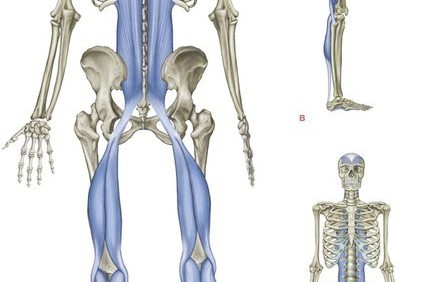The Foot Bone's Connected To The Neck Bone
Posted Feb 22, 2021 at 16:36
Posted Feb 22, 2021 at 16:36

Have you ever thought why if you come to the clinic let�s say neck pain we do an assessment and end up treating your feet?
Well, there is a very good reason for that.
At the clinic we always look at how things are connected in our body and how stress and trauma in one place can affect other areas. It would be too easy to just say that everything is connected in our body. It is but it also helps to know how things are connected. This is when we look into fascia lines and interlinks � yes, the links between the opposite shoulder and hip and so on.
The Superficial back line is one of the cardinal fascial lines in our body. It runs from the bottom of the toes around the heel and up at the back of the body all the way to the brows. With knees extended- straight legs, it forms one continuous line. When the knees are bent, it is divided into two sections. That explains why it is easier to perform forward fold- fingers to toes with knees bent. When we try to touch fingers to toes with legs straight, we are asking the whole superficial back line to lengthen. Once the knees are bent, part of the superficial fascia lines is relaxed and there is less room for pull and making the exercise easier.
The superficial back line plays important postural role in supporting the body in full upright extension. In the human development, the muscles of the SBL lift the baby�s head from embryological flexion into extension and then finally into upright standing position.
Because we are born in flexed position, the development, strength, competence and balance in the superficial back line is linked with maturity in child�s development.
However is does not only functions is spine and hip extension but also in knee flexion of the knee and ankle.
Constant postural demand on the superficial back line requires extra heavy sheets and bands in the fascial portion. This is why in the superficial back line there are strong tissues such as the Achilles tendon, hamstrings, scarotuberous ligament, thoracolumbar fascia, the erector spinae and the occipital ridge.
Common postural compensations patterns associated with the SBL include dorsi flexion limitation, knee hyperextension, hamstring shortness, anterior pelvic shift, sacral nutation, lordosis, extensor widening in the thoracic flexion, subopccipital limitation in leading to upper cervical hyperextension, anterior shift of the occiput on the atlas, and eye- spine movement disconnection.
The general concept of the myofscial lines is that strain, tension, trauma, and movement tend to be passed through the structure along the lines of transmission. This is why when we are looking for a reason why pain occurred, we are looking along the fascial lines. The pain would normally occur in the weakest point along the line � let�s say the sub occipitals- but the reason for it may be tension in plantar fascia. This is why, the treatment may include area that is not even close to where the symptoms are present.